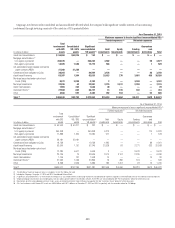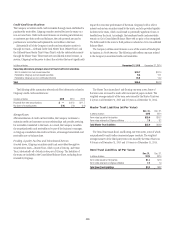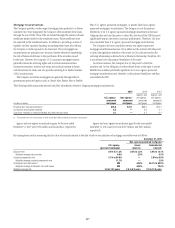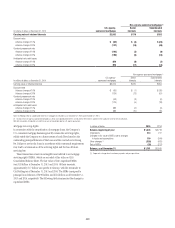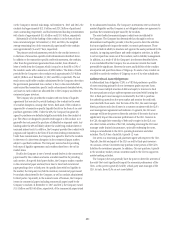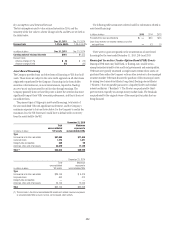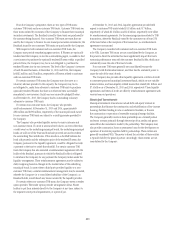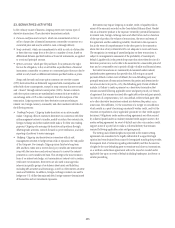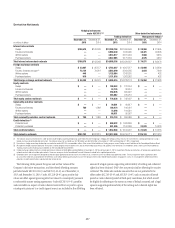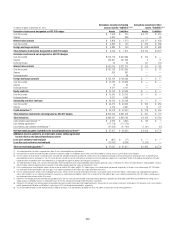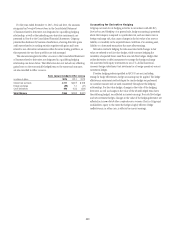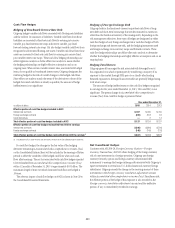Citibank 2015 Annual Report Download - page 251
Download and view the complete annual report
Please find page 251 of the 2015 Citibank annual report below. You can navigate through the pages in the report by either clicking on the pages listed below, or by using the keyword search tool below to find specific information within the annual report.233
From the Company’s perspective, there are two types of TOB trusts:
customer TOB trusts and non-customer TOB trusts. Customer TOB trusts are
those trusts utilized by customers of the Company to finance their municipal
securities investments. The Residuals issued by these trusts are purchased by
the customer being financed. Non-customer TOB trusts are trusts that are
used by the Company to finance its own municipal securities investments; the
Residuals issued by non-customer TOB trusts are purchased by the Company.
With respect to both customer and non-customer TOB trusts, the
Company may provide remarketing agent services. If Floaters are optionally
tendered and the Company, in its role as remarketing agent, is unable to find
a new investor to purchase the optionally tendered Floaters within a specified
period of time, the Company may, but is not obligated to, purchase the
tendered Floaters into its own inventory. The level of the Company’s inventory
of such Floaters fluctuates. At December 31, 2015 and 2014, the Company
held $2 million and $3 million, respectively, of Floaters related to customer
and non-customer TOB trusts.
For certain customer TOB trusts, the Company may also serve as a
voluntary advance provider. In this capacity, the Company may, but is
not obligated to, make loan advances to customer TOB trusts to purchase
optionally tendered Floaters that have not otherwise been successfully
remarketed to new investors. Such loans are secured by pledged Floaters.
As of December 31, 2015, the Company had no outstanding voluntary
advances to customer TOB trusts.
For certain non-customer trusts, the Company also provides
credit enhancement. At December 31, 2015 and 2014, approximately
$82 million and $198 million, respectively, of the municipal bonds owned
by non-customer TOB trusts are subject to a credit guarantee provided by
the Company.
The Company also provides liquidity services to many customer and
non-customer trusts. If a trust is unwound early due to an event other than
a credit event on the underlying municipal bonds, the underlying municipal
bonds are sold out of the Trust and bond sale proceeds are used to redeem
the outstanding Trust certificates. If this results in a shortfall between the
bond sale proceeds and the redemption price of the tendered Floaters, the
Company, pursuant to the liquidity agreement, would be obligated to make
a payment to the trust to satisfy that shortfall. For certain customer TOB
trusts the Company has also executed a reimbursement agreement with the
holder of the Residual, pursuant to which the Residual holder is obligated
to reimburse the Company for any payment the Company makes under the
liquidity arrangement. These reimbursement agreements may be subject to
daily margining based on changes in the market value of the underlying
municipal bonds. In cases where a third party provides liquidity to a non-
customer TOB trust, a similar reimbursement arrangement may be executed,
whereby the Company (or a consolidated subsidiary of the Company), as
Residual holder, would absorb any losses incurred by the liquidity provider.
For certain other non-customer TOB trusts, the Company serves as tender
option provider. The tender option provider arrangement allows Floater
holders to put their interests directly to the Company at any time, subject to
the requisite notice period requirements, at a price of par.
At December 31, 2015 and 2014, liquidity agreements provided with
respect to customer TOB trusts totaled $3.1 billion and $3.7 billion,
respectively, of which $2.2 billion and $2.6 billion, respectively, were offset
by reimbursement agreements. For the remaining exposure related to TOB
transactions, where the Residual owned by the customer was at least 25%
of the bond value at the inception of the transaction, no reimbursement
agreement was executed.
The Company considers both customer and non-customer TOB trusts
to be VIEs. Customer TOB trusts are not consolidated by the Company, as
the power to direct the activities that most significantly impact the trust’s
economic performance rests with the customer Residual holder, which may
unilaterally cause the sale of the trust’s bonds.
Non-customer TOB trusts generally are consolidated because the
Company holds the Residual interest, and thus has the unilateral power to
cause the sale of the trust’s bonds.
The Company also provides other liquidity agreements or letters of credit
to customer-sponsored municipal investment funds, which are not variable
interest entities, and municipality-related issuers that totaled $8.1 billion and
$7.4 billion as of December 31, 2015 and 2014, respectively. These liquidity
agreements and letters of credit are offset by reimbursement agreements with
various term-out provisions.
Municipal Investments
Municipal investment transactions include debt and equity interests in
partnerships that finance the construction and rehabilitation of low-income
housing, facilitate lending in new or underserved markets, or finance
the construction or operation of renewable municipal energy facilities.
The Company generally invests in these partnerships as a limited partner
and earns a return primarily through the receipt of tax credits and grants
earned from the investments made by the partnership. The Company may
also provide construction loans or permanent loans for the development or
operation of real estate properties held by partnerships. These entities are
generally considered VIEs. The power to direct the activities of these entities
is typically held by the general partner. Accordingly, these entities are not
consolidated by the Company.


